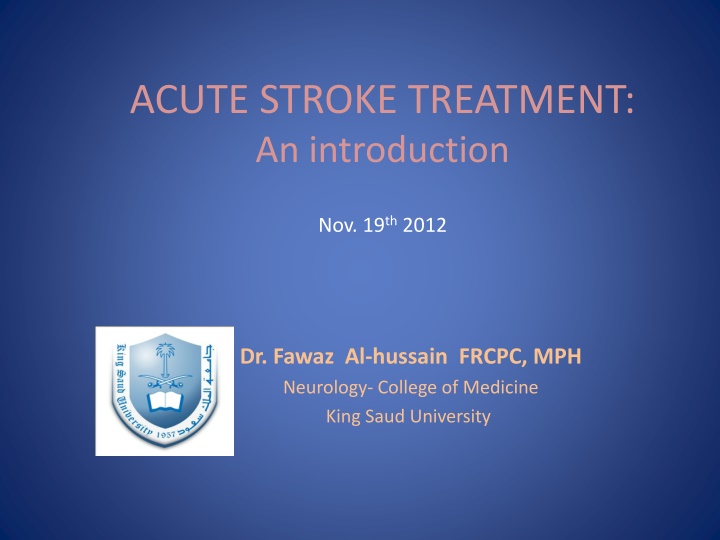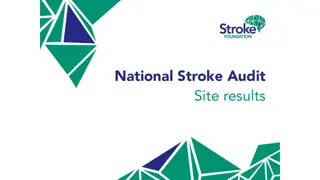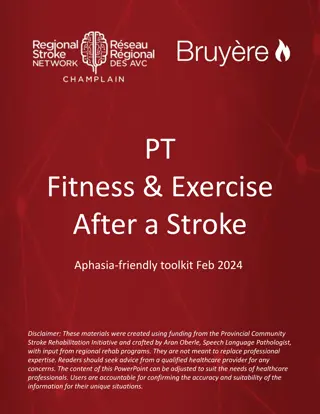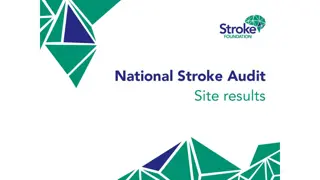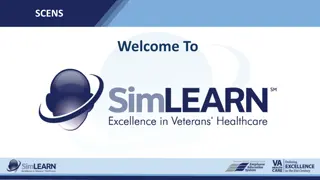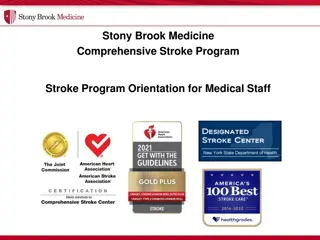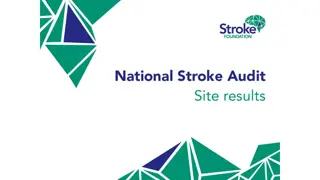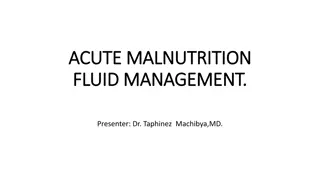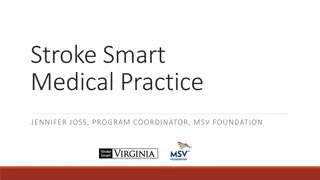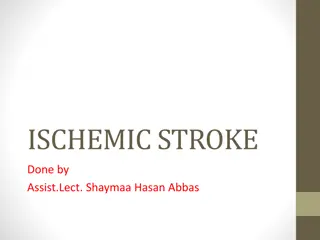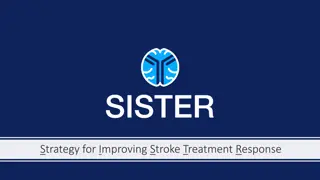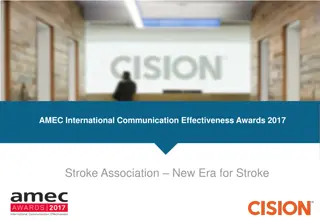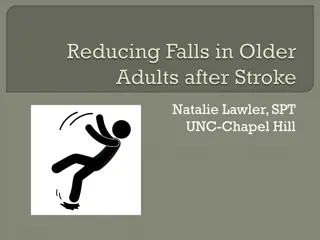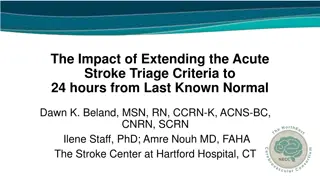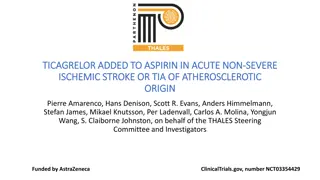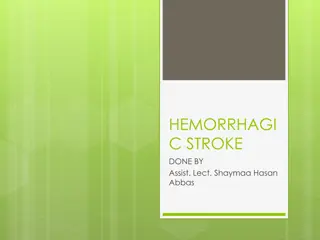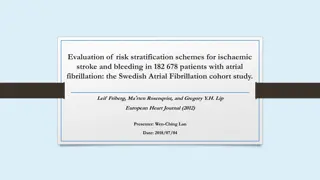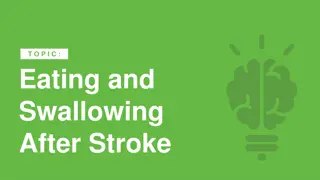ACUTE STROKE TREATMENT: An introduction
In this lecture dated November 19, 2012, Dr. Fawaz Al-hussain, a specialist in Neurology at the College of Medicine, King Saud University, discusses acute stroke treatment. The presentation provides valuable insights into the management and care strategies for individuals experiencing a stroke, emphasizing the urgency and specific approaches essential for effective treatment. Dr. Al-hussain's expertise and perspective offer a comprehensive overview of the critical measures required in handling acute stroke cases.
Download Presentation

Please find below an Image/Link to download the presentation.
The content on the website is provided AS IS for your information and personal use only. It may not be sold, licensed, or shared on other websites without obtaining consent from the author.If you encounter any issues during the download, it is possible that the publisher has removed the file from their server.
You are allowed to download the files provided on this website for personal or commercial use, subject to the condition that they are used lawfully. All files are the property of their respective owners.
The content on the website is provided AS IS for your information and personal use only. It may not be sold, licensed, or shared on other websites without obtaining consent from the author.
E N D
Presentation Transcript
ACUTE STROKE TREATMENT: An introduction Nov. 19th2012 Dr. Fawaz Al-hussain FRCPC, MPH Neurology- College of Medicine King Saud University
TYPES OF STROKE Intracerebral Hemorrhage Subarachnoid Hemorrhage Ischemic Stroke 85% 10% 5%
Stroke Treatment: Primary Stroke Prevention Acute Stroke Treatment Secondary Stroke Prevention Stroke Rehabilitation
Stroke Treatment: Primary Stroke Prevention Acute Stroke Treatment Secondary Stroke Prevention Stroke Rehabilitation
Acute Stroke Treatment Ischemic
Modalities of Acute Stroke Treatment: IV t-PA (standard) IA t-PA Mechanical Disruption Surgical Rx (old)
) IV t-PA NINDS+ ECASS III) Inclusion criteria: Exclusion criteria: Intracranial Hge in imaging or clinical presentation suggests SAH Active/ recent internal bleeding or on warfarin with INR > 1.7 or platelets < 100K Serum Glucose <50 or > 400 Systolic BP > 185 or diastolic >110 Recent MI (3/52) Recent (2/52) major surgery or trauma Recent arterial puncture at non- compressible site Clinical Dx of stroke Stroke onset < 270 minutes Age is > or = 18 Others (see NINDS protocol)
) IV t-PA NINDS+ ECASS III) Stroke onset: timing of first neurological deficit OR last time pt was seen well TIA: has to end with complete neurological recovery IV t-PA (alteplase) 0.9 mg / kg to a maximum of 90 mg 10% bolus over 1 minute then infuse rest over 60 minutes Hold infusion and re-evaluate the pt in case of HTN (S>185,D>110), sudden headache, or sudden reduction in LOC
Stroke Penumbra CEREBRAL BLOOD FLOW (ml/100g/min) Normal function 20 Reversible Neuronal dysfunction 15 CBF 8-18 PENUMBRA 10 Neuronal death 5 CORE CBF < 8 1 2 3 TIME (hours)
Stroke Penumbra: The target of acute stroke Rx!!
Cranial Collateral Arteries: Penumbra suppliers External: Internal:
IA t-PA PROACT II trial (published 1998): A small study with 40 pts actively included Safety and recanalization rate with IA rpro-urokinase for proximal MCA stroke within 6 hrs compared to placebo significant increase in recanalization (p< 0.01) but hemorrhagic transformation (15.4% vs. 7.1%) Suggested superiority of IA thrombolytics delivery
IA t-PA Interventional Management of Stroke (IMS-III) trial: Intervention: 0.6 mg IV t-PA over 40 minutes + Endo-arterial intervention < 22 mg IA t-PA over 2 hrs OR thrombus removal device OR IA t-PA with US energy Control: active with IV t-PA (standard protocol) Trial is still ongoing
Endoarterial Mechanical Disruption Merci Retriever: first FDA approved device Increased recanalization rate and secondary clinical outcome when used for large cerebral arteries
Endoarterial Mechanical Disruption Penumbra system: FDA approved It does: clot suctioning Similar rates of recanalization and clinical outcomes to Merci retriever
Endoarterial Mechanical Disruption 3rdGeneration of devices Solitaire Device: Solitaire was superior to Merci in Swift trial Trevo was superior to Merci in Trevo II trial Trevo retriever:
Endoarterial thrombolysis: Combined IA and Mechanical disruption General recommendation: For M1 (MCA) clot For Basilar artery clot In certain cases where IV t-PA can not be given e.g. patient is on warfarin or recent MI Limitations: Time (should not delay IV t-PA initiation) Expertise ? Costs
KEY TIME INTERVALS Perform an initial patient evaluation within 10 minutes of arrival in the ER Notify the stroke team within 15 minutes of arrival Initiate a CT scan within 25 minutes of arrival Interpret the CT scan within 45 minutes of arrival Ensure a door-to-needle time for IV rt-PA within 60 minutes from arrival
Recommended strategies: Advance hospital notification by EMS Rapid triage and stroke team notification Single call activation system Rapid access to CT and rapid interpretation Rapid laboratory testing (point of care) Mix t-PA a head of time Team-based approach
Barriers for Acute Stroke Therapy Late patient presentation to ER (In USA; only 30% present within t-PA window) Poor stroke recognition and delayed triage at ER (mainly for un-usual stroke presentations) Lack of appropriate infrastructure Lack of acute stroke expertise Presence of a contra-indication Difficulty in getting patient s or family s verbal consent
Acute Ischemic Changes in CT Loss of gray-white matter differentiation and sulcal effacement
Acute Ischemic Changes in CT Hyper dense MCA
Acute Ischemic Changes in CT A 45 yr old male with weakness in Lt side for 2 hrs
Acute Ischemic Changes in CT A 45 yr old male with weakness in Lt side for 2 hrs Obscuration of lentiform nucleus
Case (1): A 60 y.o lady with acute stroke few hrs post IV t-PA . She is known with HTN and controlled DM-2
Case (1): A 60 y.o lady with acute stroke few hrs post IV t-PA . She is known with HTN and controlled DM-2 Oro-lingual angioedema
Case (2): 21 y. o man, a university student presented to ER with Left sided throbbing headache and mild expressive aphasia. Nothing else. NIHSS: 2 PMHx: Migraine
Case (2): 21 y. o man, a university student presented to ER with Left sided throbbing headache and mild expressive aphasia. Nothing else. NIHSS: 2 PMHx: Migraine Acute Left MCA (upper division) ischemic stroke with (N) CT brain
Case (3): A 53 y/o male with sudden reduction in LOC, jerking in 4 limbs, and difficulty in breathing. Got intubated in ER then CT brain was done PMHx: smoker, HTN
Case (3): A 53 y/o male with sudden reduction in LOC, jerking in 4 limbs, and difficulty in breathing. Got intubated in ER then CT brain was done PMHx: smoker, HTN Acute Basilar artery stroke
